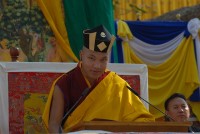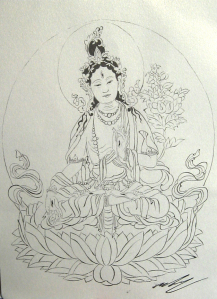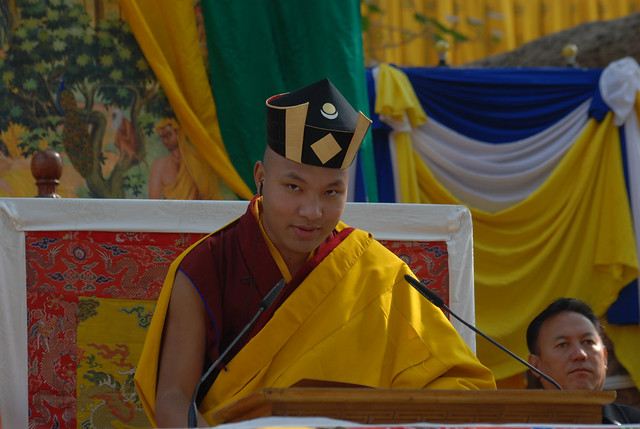法王新闻 | 2009年01月
『第26屆噶舉祈願法會』第四天日誌
『26th Kagyu Monlam』Day 4
時間:2009年01月07日 January 07, 2009
地點:印度 菩提加耶 Bodhigaya, India
報導:黃靖雅
攝影:噶瑪善治、噶瑪諾布 、班瑪歐色多傑
法王指導以「佛陀苦行相」禪修 並說聖度母「七救護文」
His Holiness Continues the Story of Milarepa
第一座法

上午6:00,嘉察仁波切陞座傳戒,傳授漢傳稱「八關齋戒」的「大乘布薩戒」。接著維那師帶領大眾以梵文念誦〈三常誦〉(大祈願課誦本無梵文版),再以藏文依序念誦:
1.〈皈依發心〉(大祈願課誦本P35)
2.〈祈願儀軌二十支〉(大祈願課誦本P38)
3.〈相好讚〉(大祈願課誦本P73)
4.〈慈氏讚〉(大祈願課誦本P101)
5.〈懺悔支〉(大祈願課誦本P144)
而後迴向,圓滿第一座法。
第二座法
上午9:00,法王噶瑪巴陞座主法,開示之前,先舉行功德主供養儀式,再繼續講授「密勒日巴大師傳」,今天說到密勒日巴返鄉之後情景。
尊者返鄉後,發現昔日鄉中首富「四樑八柱之家」已成鄉人不敢近的鬼屋,母親已死,妹妹琶達不知流浪到哪裡去,傳家寶《大寶積經》幾乎變成老鼠和小鳥的窩巢。然後看見一個土和爛衣裹在一起的大土堆,上 面長滿野草,尊者用手搬開,發現有一大堆人骨頭,想起這是母親的尸骨,心中一陣劇痛,竟昏倒在地上。
尊者醒來,想起上師的口訣,就觀想把母親的神識、自己的心與口傳上師的智慧心融合在一起,將頭枕在母親的骨頭上,身、口、意剎那不散亂地印入大手印三昧,經過七晝夜,親眼見到父親和母親都脫離了苦趣, 超升到淨土。
七天後,尊者從三昧定起。仔細思量,所有輪迴一切法都毫無實義,世間的一切,實在一點意思都沒有。就把母親骨頭作一個佛像,把《大寶積經》供養在佛前,決心到護馬白崖窟去,不分晝夜拚命修行,並且發 誓:「如果心不堅持,為世間八風(「八風」即「世間八法」──苦、樂;貧、富、毀、譽;貴、賤;此八者能煽動行者之心,故名八風。)所動,寧願自殺也不願為其所誘惑。如果心中起了絲毫求安逸快樂之心,願空 行護法斷取我的生命。」
尊者就把母親的殘骨收集好,把寶積經上的鳥糞掃乾淨,發現雨淋損毀之處還不太多,字跡還看得很清楚,便把母親骨頭和寶積經一齊背在背上。對輪迴世間生出極端的出離心,決計捨棄世間,去勤修正法。他走 出家門,唱了一首「覺悟世間虛妄歌」:──
聖不動自性大悲尊, 一如上師所預示;
於此惡魔故鄉裡,示現無常幻化師。
願依如實此教師,令我頓生大決心;
世間所現一切法,無常無依恆變易。
輪迴諸業無義利,與其勤求世間利,寧修佛陀解脫法。
父在之時子不在,子在此時父已逝;
二人縱聚亦無實,孺子我往修正法;修禪護馬白崖窟。
母在之時子不在,遊子歸時母已逝;
二人縱聚無實義,孺子我往修正法;修禪護馬白崖窟。
妹在之時兄不在,兄歸家時妹飄零;
二人縱聚無實義,兄修有義之佛法;修禪護馬白崖窟。
有家之時主不在,主歸家時家已敗;
二者縱聚無實義,主修有義之佛法;修禪護馬白崖窟。
聖經有時無供者,供者歸時經已壞;
二者縱聚無實義,行者我往修正法;修禪護馬白崖窟。
耕田在時主不在,主人歸時田已無;
二者縱聚亦無實,主人我往修正法;修禪護馬白崖窟。
故鄉故家與故園,皆是輪迴無實法;
播弄愛著無實義,行者我往求解脫。
修禪護馬白崖窟,承恩法父馬爾巴師,加持令我得山居。
尊者找到昔日教他識字的老師的兒子,想把《大寶積經》和母親遺骨做成的佛像,托他找地方供奉,自己打算依上師囑去住山修行。老師的兒子勸他說,你可以學你的上師結婚,娶了未婚妻結賽,在家弘揚佛法呀 。尊者聽了答道:「獅子跳躍的地方,兔子不自量力跟著去跳的話,一定會摔死的。」
尊者說,「在世上,除了上師的口訣和修行之外,其他的一切我都不要。我到崖洞去修行,就是對上師的最好供養,就是承繼上師的宗風,也就是令上師歡喜的最好方法。利益眾生,弘揚佛法,也只有修行才能辦 到;超度父母,也只有修行才能辦到;自利,也必須有賴於修行。」
尊者說,這一次回鄉,看見家破人亡,深深覺悟到人生空幻無常。人們拼命賺錢,千辛萬苦成家置產的結果,亦只不過是一個幻夢,讓他生出無比的出離之心。「房屋就像火宅一樣」,尊者說,「看透了人生的我 ,將不顧貧窮、飢餓和他人的譏笑,決心盡形壽,為自己、眾生的一切利益去修行。」
His Holiness drew several lessons from Milarepa’s story to illustrate how we should practice. The first concerned our commitment or rather lack of it, and our inability to tolerate hardship.
持守最初的誓願,直到證悟「可見實修很重要」,法王針對密勒日巴這段故事說,以前的祖師,修行都是經過千辛萬苦的,像馬爾巴大師兩次到印度向那洛巴大師求法,都是徒步從西藏走到印度,把經典帶回西藏,吃足了苦頭,哪像我們現 在搭個巴士、火車、飛機就說有多辛苦。
Like all the great masters in the lineage, Milarepa renounced the world, expressed his disgust with samsara, and had a fierce determination to practice the Dharma. He knew that this was the only way to bring benefit both to him and to others, including his dead parents. We, on the other hand, relax and enjoy good food.
The great translator, Marpa Lotsawa, endured many difficulties on his journey to India. He had to trudge across the never-ending Indian plains, and yet he translated all those texts! These days we get tired when we travel by train or plane!
密勒日巴為依上師囑咐,以大苦行淨除罪障,一個人背著木石建九層塔,建了拆、拆了建,直到今天,都還可以在Sugaguto地方看到那座塔,塔身建築有石有木,簡直難以想像是一個人蓋出來的。法王說,我曾經 到那個地方朝聖,木頭都很樸素,看得出是一個人一石一木慢慢蓋出來的;我還曾經去看過當年尊者在馬爾巴大師灌頂時,被趕出的會場所在地,感受他所曾經歷的痛苦。尊者從小父亡,母妹和他都變成僕人,長大後 為復仇學了咒術殺人,之後深自懺悔,決心終身修行
Milarepa demonstrated immense commitment. Marpa set him to build four houses – not small but big ones – and then he had to take them down again, stone by stone. He was even made to build a house with nine storeys, which His Holiness had had chance to visit. His Holiness commented that the house looked like it had been built by one person – the pillars were unfinished wood and the construction generally was very rough. When Marpa threw him out of teachings or beat him, Milarepa still persevered.
岡波巴大師本來有一個妻子、兩個兒子,但都在大瘟疫中死去,也讓他從無常中對輪迴生起出離心,他就在妻子臨終要求下,立誓出家終身修行。
Gampopa too had to face great hardships. He was a householder with a wife and two children, until an epidemic killed first his children and then his wife. When his wife was on her deathbed it seems she was worried that he might remarry, but he reassured her that his only attachment was to the Dharma.
第一世法王杜松欽巴,則因所愛的人被搶走,憤而以誅術殺人,之後懺悔,立誓修行。法王這裡補充說,明就多傑在杜松虔巴的傳記中註釋說,可能是杜松虔巴長得像猴子,容貌醜陋,他愛的人自己跑掉的;杜松 虔巴因此發願說,我未來世都要長得相貌莊嚴,這也就是為什麼後來每一世法王,相貌都長得還算莊嚴吧。
The First Karmapa, Dusum Khyenpa, also had an interesting background. It is said that something happened when he was fifteen that changed his life. There are two explanations given, either he murdered his father’s enemy, or he murdered the man who ran off with his girlfriend. However as Dusum Khyenpa was quite ugly and looked like a monkey, perhaps his girlfriend had left him. Whatever happened, he became very sad and out of this experience came his decision to commit his life to practising Dharma. Gyalwang Karmapa grinned, “Because he was ugly, Dusum Khyenpa made a special prayer that in future all Karmapas should be handsome!”
「我們要持守最初所發的誓言,不要改變」,法王說,當杜松虔巴對世間生起堅定如山的出離心,誓願修行,他就終身持守這個誓言,直至證悟。《入菩薩行論》也說,「要嘛不開始,開始了就要完成。」法王提 醒,這是指清淨善業哦,善業開始了就不要中斷,但可不要當成不止息惡業的藉口。有個屠夫天天都要殺一頭豬,他的刀每天都是紅的,有一天自己也覺得這樣不好,但繼而又想道:「這是眾人要吃的,大家會和我一 起分擔惡業吧…」世間人都是這樣想的,自己造惡業,卻想別人會不會一起來承擔。「自做,叫他做,隨喜所做」都有業力,但以「自做」最重,法王提醒:「無論是不是佛教徒,都不可以傷害有情」。
According to His Holiness it seemed that when things were going smoothly we forgot about Dharma. This showed lack of commitment. It was essential to have determination and an aspiration that we put into practice. This applied not only to monks and nuns, but to householders too. If someone has never begun to do something, there was no problem, but if they had already made a commitment, they had no choice – they had to follow through to the end. A good person should never give up the Dharma.
His Holiness told a story about a pork butcher who killed a pig a day, and a total of 360 pigs a year. He was well aware of what he was doing, that his life was stained with blood, but excused himself, “It’s the only livelihood I’ve got. It’s not that I want to kill pigs, but that society wants pork.”
In this way, he transferred the blame and responsibility from his own shoulders to the larger community. But that is not how it is. Whether you are a Buddhist or not, it is of benefit to you to do something positive with body, speech and mind. If you are a Buddhist, you have promised to give up the ten non-virtuous actions and you have taken vows. If you disrespect these commitments and engage in negative actions, the result will not be good.
混雜三毒做佛事,是傷害眾生的所有的修行,都是為了對治煩惱,「要像軍人,對抗煩惱,不可以違背軍人的誓言,臨陣脫逃,討好敵人,不敢和敵人對抗,都是很丟臉的。」八萬四千法,都是為了對治不同的煩惱,就像彌勒菩薩所說:「佛陀 所制戒,精確如武器」,所有的戒律,包括三昧耶戒,都是為了幫助我們對治無明煩惱的。
Next, His Holiness returned to the subject of breaking samaya. He explained that if you were unable to keep every detail of samaya, you might not be breaking the samaya, but, on the other hand, if you became careless or showed disrespect, you would be breaking the samaya, especially monks and nuns. You would be like someone who enlists, puts on armor, goes to the battlefield and then runs away. Continuing the analogy, His Holiness likened Rinpoches and Lamas to the generals, and the monks and nuns were like warriors. The enemy was the three poisons and the afflictive mental and emotional states. If you just give in when the enemy of afflictive emotions attacks, it is very shameful. You have surrendered to your enemy and become his slave. That is not the behavior of a warrior.
His Holiness pointed out that each of the 84,000 teachings of the Buddha were designed to work on one of the poisons. Every one of those teachings was like a sharp weapon against the poisons and afflictive emotions. All the commitments were about conquering them.
法王說,今天密法傳到世界,有些上師會以三昧耶戒威脅弟子,說如果破戒就會下金剛地獄,把三昧耶戒說得太神秘了,其實只有輕蔑上師、故意違犯才算破戒,「一切惡業的根本是煩惱,戒律是要幫助我們去除 煩惱的。」「持守三昧耶戒,是為了對治我們的煩惱,除此以外,沒有別的。」
Sometimes people misunderstood the meaning of samaya. “Do you have a book called ‘Samaya’, please?” he joked. But, in essence, both samaya and tsultrim [ethical behavior] meant working on our negative emotions. We had to see the mind poisons very clearly as something really negative and undesirable. Then we had to work to overcome them, otherwise they would lead to suffering for ourselves and others, and to rebirth in the lower realms.
不過有些人以為修持就是要硬撐著,修「忍辱」是硬撐硬忍,起了嗔心,就猛念嗡嘛呢唄咩吽,想用六字大明咒壓住,心想我要忍著我要忍著,不是這樣的,又不是練硬功夫。惡業就像大便一樣有惡臭,一聞就知 道要離得遠遠的,有人叫你吃,你會說「你自己去吃」。
His Holiness used anger as an example. Sometimes, if he became a little angry, he confessed, he became aggressive. Some people considered anger and aggression to be helpful, but they were fooling themselves. “We are practising patience not kung-fu,” he quipped. If someone told us, “Kyakpa za!” [a common form of mild abuse in Tibetan meaning “Eat shit!”] Our response was usually “You eat shit!” but perhaps it would be better to think along the lines, “I wonder what it tastes like? Perhaps it’s sweet.”
法王說,有些人不知道自己的煩惱,不懂得以佛法對治,還說自己都是為佛法、為噶舉,但心所想和行為卻相反,不知道煩惱的過患卻做佛事,是傷害佛法的;做佛事卻混雜著貪嗔癡三毒,是傷害眾生的,倒不如 不做。還貪著此生,就不是一個佛法行者。
When we realized the need to rid ourselves of these mind poisons, practice became an ornament not a burden.
His Holiness gave another example. If people who wanted to work for world peace failed to understand the negativity of the mind poisons, in spite of a fine aspiration, they could not succeed because all their endeavors would become mixed with pride, arrogance or other mind poisons, which infiltrated their good intentions. In a similar way, when someone wanting to work for the Dharma failed to understand the afflictive emotions the result could be like good food mixed with poison. If, for example, the person has the poisons of aversion and attraction, this could lead to sectarianism, so that even if they were trying to preserve the Dharma, because of the intrusion of their negative emotions, they would end up harming it.
His Holiness reminded everybody, “It is said that the Buddha Dharma is the source of all benefits, but that depends on being a good Dharma practitioner too.”
有些人連吃一塊麵包都要供養迴向,但做佛法的事卻反而很輕忽,那就像一萬元的東西隨便用100元賣掉了,那是蹧遢珍貴的佛法,「如果你為佛陀、為教法做事,要謹慎,因為那是整體之事,會影響到眾人。」所 以我們要隨時提醒自己,做佛法的事,不要混雜貪慾、嫉妒,如果混雜人我之見、宗派之別,那就會沈淪到輪迴的更深處去了。「要放下自己,才會看見整體的利益和價值。」「要觀眾生如母、生起慈悲心,那就從眼前 一位你真的很容易對他的悲喜有感受的人開始。」
We needed to make the aspiration to be good Dharma practitioners, otherwise we would be selling the Dharma short, like selling something for 100 rupees when it was worth 10, 000.
His Holiness concluded by reasserting that the Dharma was the path to true and lasting happiness for ourselves and others. As to our own happiness, we had the choice to practice or not, but if we chose to work for the Dharma, more than our own welfare was at stake. We had committed ourselves to working for the benefit of all sentient beings, and that meant it should never be mixed up with envy, jealousy and pride. Sectarianism was particularly dangerous to the Dharma. Our work for others had to be based on compassion and the realization that other sentient beings are just like us in that they want happiness and they do not want suffering. We should view all the beings of the six realms as like our mothers.
法王說,今天是這次法會最後一天說「密勒日巴大師傳」,未來如果沒有無常我們再繼續說,「在聖地說祖師的故事,讓我覺得自己很幸福。」明後天要做度母加持灌頂,並且說說度母法密乘前行的解釋。接著, 唱道歌吧。
維那師帶領大眾唱頌──敬禮馬爾巴譯師前,凡欲學佛修行者,
若不依止具相師,雖有恭敬無加持。
甚深灌頂若不獲,執續部義徒自縛;
不以續部為依準,一切作儀成謬誤。
若不修觀深秘訣,捨世間法徒自苦;
不能降伏諸煩惱,巧舌如簧皆空語。
不明甚深方便道,雖常精進無利益。
不明玄奧三要點,雖勇猛修路遙遠;
不集廣大之福德,徒求自利輪迴因。
雖集福德不求法,勤修亦難成功德;
知足乃是無價寶,遠勝黃金千萬億。
身內安樂若不生,尋求外樂痛苦因;
愛名魔心若不除,終將自敗惹煩惱。
貪樂則為五毒惱,物慾終使慈悲離;
驕傲自慢是非因,獨居自無口舌災。
心離散亂修專住,寂處能邀勝伴來;
安守卑下得上位,緩行偏能成速達。
捨離諸事大事興,守甚深道道速成;
若證空性悲心生,悲心生處自他泯。
無自他故能利生,利他事成重見我;
由見我故成佛陀;我與佛陀暨佛子,
無差別觀應祈請。
接著,禪修。法王本來說,我們今天安住在空性中,但想了一下又說,我們還是明天再安住在空性中吧。今天安住在「佛陀苦行相」。
His Holiness then led a short meditation on the Lord Buddha, when he was meditating in the area around Bodhgaya for six years, practicing asceticism.
釋迦牟尼佛捨離世間一切而修了六年苦行,今天巴基斯坦博物中還收藏著一尊描述佛陀當年六年苦行瘦骨如柴的苦行雕像。佛陀為了眾生而出家修苦行,如果我們像餓鬼一樣貪婪,貪財貪名貪利,肚子大大、喉嚨 細細,就像個餓鬼一樣,雖然看似布施,卻是為了已利,那就像個貪婪的餓鬼,是對不起佛陀的。今天,我們就觀想「佛陀苦行相」,生起出離心,這樣進行禪修、安住,但身要還是要把握住(法王開笑玩說,有些人 脊椎是有毛病嗎?怎麼就直不起來,老是彎彎的)。
His Holiness reflected on how we ourselves were like hungry ghosts, chasing after food, wealth, fame, and all the attractions of this life, never considering the next life, whereas the Buddha renounced the world in order to bring benefit to limitless sentient beings as vast as space. We were a disgrace to his name.
大眾以「佛陀苦行相」為心的所緣境,寂靜安住,禪修五分鐘。


五分鐘後,法王說:「好了好了,這樣就好了,入定太深就醒不過來了。」
接著,先進行禪修完畢的迴向,然後法王獨誦〈大祈願文〉、〈冥陽迴向文〉。而後再迴向,圓滿第二座法。
第三座法
下午1:30,法王陞座,針對〈七救護祈請文〉(大祈願課誦本P335)作開示。
第一個偈頌──
母於無生法界中,安住尊聖之度母,了諸有情安樂母,祈救護我出怖畏。
法王說,度母雖然安住在法身境界中,但為了以大悲心救度一切眾生,還是示現了一個色身,我及一切有情祈請度母救護我們內外一切怖畏,包括外在如大象、獅子,內在如無明、疾病等種種怖畏。
第二個偈頌──
不識已即法身故,心為煩惱力所縛,流轉輪迴如母眾,懇請佛母慈救護。
法王說,進入法道的修持之後,我們修持時,所獲得最殊勝的果位是涅槃,而障礙我們獲得涅槃的是無明,以及種種的愚癡,對於被無明障覆而沈淪於輪迴的眾生,我們祈請度母能給予救護。
第三個偈頌──
法義於心未生際,唯隨名言及文句,下劣宗義所矇騙,清淨佛母祈救護。
法王說,這樣修行之後,在大乘之中,最殊勝的是甚深的空性教法,對於這樣的意義不能了悟,只是根據名相、文字來理解,或者是入了邪見的宗派,或者是一些不是最殊勝的法教傳承中,我們都祈請聖度母來救 護。
第四個偈頌──
難能了悟自心性,見已於彼未修持,為諸惡行所散亂,正念佛母祈救護。
法王說,最難了悟的是自己的心性,一旦見到之後,卻不去繼續修持,讓自己的身心放逸在惡劣的不善法當中,不知道精進,不知道在一座法當中,對了悟生起強烈的希冀心,對這樣行者,我們祈請聖度母能給予 救護。
第五個偈頌──
自生無二之本慧,執為二之習氣故,一切所作皆繫縛,心無二母祈救護。
法王說,心的本質是清淨的,即使不依靠外在的力量,依著自己修持的力量,也是可以從自己心中自生起這樣的智慧的。但是能所二執(執著能取、所取二者為實有)的習氣,卻障礙了我們,不能現證這樣的智慧, 對於這樣被最微細的二執習氣所障礙的眾生,佛母啊,我們祈請您賜予救護。
第六個偈頌──
雖安住於清淨義,不識因果緣起故,於所知義起愚矇,遍智佛母祈救護。
法王說,對於正確的空性義理中,不了解顯空不二、顯空無礙的義理,對於這樣的眾生,度母我們祈請您救護。
第七個偈頌──
離戲具足虛空性,一切與彼無別故,現今弟子有情眾,圓滿佛母祈救護。
對於證悟一切遠離戲論的真實法,及對一切平等的法義不了知的眾生,對於尊聖的救母有著寄望的眾生,入於非法道的障礙,度母祈請您救護。
這是直貢怙主吉天順恭親見七位救度母後,所做的祈請文,大部分和法性及實修的義理都是相關的。
隨後,維那師帶領大眾唱頌──
1.〈七救護祈請文〉(大祈願課誦本P335)
2.〈綠度母讚.天人頌〉(大祈願課誦本P337)
3.〈白度母讚文〉(大祈願課誦本P346)
4.〈妙音天女讚頌.加持靈光〉(大祈願課誦本P350)
5.〈了義大手印祈願文〉(大祈願課誦本P402)
而後迴向,圓滿第三座法。
第四座法
下午3:30,維那師帶領大眾念誦──
1.〈達隆噶舉二十願文〉(大祈願課誦本P417)
2.〈無分別持教長壽願文〉(大祈願課誦本P274)
3.〈長壽願文〉(見長壽文本)
4.〈護法供儀〉(大祈願課誦本中文無)
5.〈雪域安樂願文〉(大祈願課誦本P460)
6.〈最勝導師〉(大祈願課誦本P280)
7.《月藏經》(大祈願課誦本P269)
8.〈成就實諦文〉(大祈願課誦本P320)
而後迴向,圓滿第四座法。
今日因雨,法會提早結束,最後幾首願文唱頌時,時值乾季的菩提迦耶,忽然下起雨來,全體僧眾繼續安坐原地,多數僧眾沒有雨具,在雨中繼續唱頌,情況有點狼狽,但很觸動人心。
活動短訊

下午4:00,第四座法期間,法王在德噶寺大殿,送「噶舉學會」會員和華人、韓國弟子,每人一張法王最新手繪的白度母像,讓大家明天度母灌頂時觀想用,法王並細心的一個一個現場簽名,領到的信眾都非常歡喜, 人人臉上漾著滿足的微笑步出大殿。
Later that day: Approximately five hundred members gathered in the assembly hall at Tergar Monastery, waiting expectantly for His Holiness. Seated quietly in rows, the array of races and nationalities truly illustrated the international nature of the Kagyu Monlam, and the bond of friendship through the Dharma which has united people from all five continents.
His Holiness arrived, walking briskly and energetically, he smiled and bowed his head before sitting down in an armchair specially placed below the dais.
Having recited a blessing, His Holiness gave a short speech, in which he compared the growth of Kagyu Monlam to the growth of a fruit tree. The seed had been planted twenty-six years ago, with the inception of the Kagyu Monlam in India, and now the tree had grown to maturity, its branches had spread and were fruit-bearing. Continuing the analogy, fruit trees needed the right conditions in order to grow, and His Holiness acknowledged the support and generosity of the Kagyu Monlam Members which had provided the conditions for the growth of Kagyu Monlam.
Others were now benefiting from the fruit and it was His Holiness’ aspiration that these auspicious conditions would continue to ripen, and that those of us who lived on this earth would leave behind a good imprint. Kagyu Monlam was the foundation for creating an imprint of virtue, well-being and harmony for the future. It was a mandala which attracted goodness.
His Holiness then showed everybody a postcard-sized print of one of his own drawings, a White Tara, which he wanted to share with them. He apologized that it had not turned out as he would have liked, but assured everyone that he had drawn it with one-pointed concentration. It was a symbol of the one-pointed concentration with which he regarded all his followers, and was linked with the Tara empowerment he would give on Friday. Finally his hope was that by the merit accumulated from participating and supporting Kagyu Monlam, all those present would be absorbed into the Tara mandala of longevity.
Settling down with the prints on a table in front of him, His Holiness joked that he’d brought a lot of pens with him in order to sign the prints. Members then came forward, one-by-one, to present their khatags, and each received a freshly-signed print, the ink still wet, directly from the hand of the Gyalwang Karmapa.
Clutching their prints, the members moved reluctantly away from His Holiness and left the hall with radiant faces. Many had tears in their eyes. Through the power and grace of His Holiness, this had been an extraordinarily precious experience for everyone, a moment of transcendence, out of time and the ordinary dimensions in which we live our lives. It would be a memory to treasure when they returned home, a source of strength in the future, and a reassurance that the Gyalwang Karmapa sincerely holds every one of his disciples in his heart and mind.
大藏經抬經預演,法王親身示範晚上6:40左右,在德噶寺大殿,法王親自為各寺院代表喇嘛,教授示範如何抬大藏經,為第七天抬大藏經繞塔儀式作預演,法王像位中學老師,示範動作,既嚴格要求,中間也穿插逗趣動作,惹得年輕僧眾大笑。
